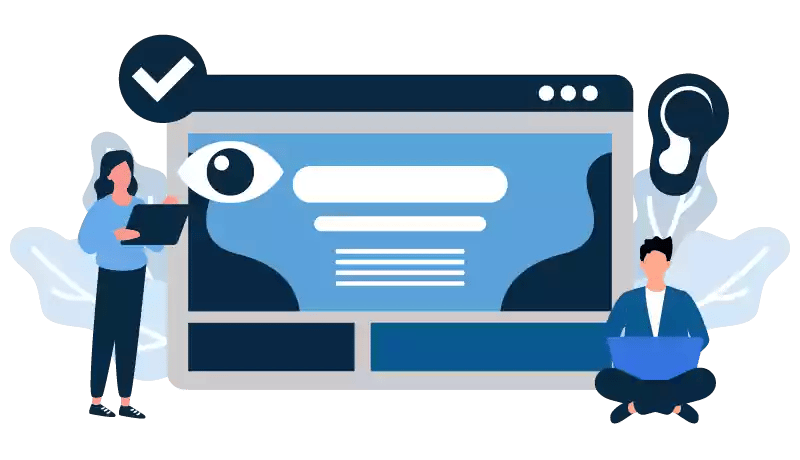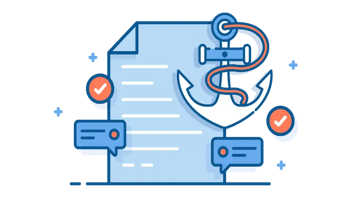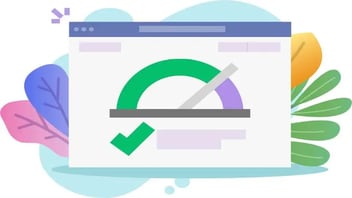Ce este accesibilitatea web și de ce este importantă?
În peisajul digital actual, incluziunea este extrem de importantă. Imaginați-vă navigarea pe internet fără a vedea imagini sau fără a auzi sunet - aceasta este provocarea pe care accesibilitatea internetului își propune să o depășească.
Haideți să descoperim de ce este importantă accesibilitatea web și cum modelează aceasta viitorul internetului.

Înțelegerea accesibilității web
Accesibilitatea web este piatra de temelie a unui peisaj digital care valorizează incluziunea și accesul egal. Aceasta implică proiectarea și dezvoltarea de site-uri web pentru a se asigura că acestea pot fi utilizate eficient de persoanele cu o gamă largă de dizabilități. Aceste dizabilități cuprind diverse provocări, inclusiv deficiențe de vedere, limitări auditive, diferențe cognitive și deficiențe motorii. Scopul final al accesibilității web este de a facilita și îmbunătăți UX pentru toți vizitatorii, de a elimina barierele, permițând tuturor să perceapă, să înțeleagă, să navigheze și să interacționeze cu conținutul online fără probleme.
În esența sa, accesibilitatea web înseamnă recunoașterea faptului că oamenii experimentează web-ul în moduri diverse.
-
Deficiențele vizuale pot include orbirea sau vederea slabă, necesitând ca site-urile web să ofere text alternativ pentru imagini și fonturi de dimensiuni adaptabile.
-
Deficiențele auditive, pe de altă parte, necesită furnizarea de subtitrări sau transcrieri ale conținutului audio.
-
Diferențele cognitive pot implica dificultăți în procesarea informațiilor complexe, necesitând astfel o prezentare clară și concisă a conținutului.
-
Deficiențele motorii pot afecta capacitatea de a utiliza un mouse tradițional, ceea ce determină nevoia de opțiuni de navigare prin tastatură și de zone mai mari pe care se poate face clic.
De ce este importantă accesibilitatea web?
1 din 4 adulți din Statele Unite are un handicap. Cu toate acestea, doar 38% dintre site-urile web sunt accesibile persoanelor cu handicap. Observați această disparitate? Nu numai că acest lucru este incorect pentru persoanele cu handicap, dar costă întreprinderile în mai multe moduri. Lipsa accesibilității web costă întreprinderile miliarde de dolari în fiecare an. Un studiu a arătat că lipsa accesibilității web costă companiile în medie 3,6 milioane de dolari pe an.
Dincolo de aspectele tehnice, accesibilitatea web are o semnificație morală și etică profundă. Crearea de site-uri web accesibile înseamnă oferirea de oportunități egale pentru toată lumea de a accesa informații și servicii, promovând astfel o societate incluzivă. În plus, având în vedere că multe țări instituie o legislație care impune accesibilitatea web, organizațiile trebuie să se alinieze la aceste cerințe legale pentru a preveni eventualele sancțiuni și pentru a-și proteja reputația.
Inițiativa privind accesibilitatea web (WAI)
În ceea ce privește accesibilitatea web, un nume iese în evidență ca lumină călăuzitoare: Inițiativa pentru accesibilitate web (WAI). Condusă de Consorțiul World Wide Web (W3C), WAI este esențială în stabilirea standardelor și a liniilor directoare care modelează structura unei experiențe online incluzive. Această inițiativă subliniază angajamentul de a face internetul accesibil tuturor, indiferent de abilități sau dizabilități.
Născută din nevoia de a aborda provocările cu care se confruntă persoanele cu handicap în navigarea în mediul digital, WAI a fost înființată cu un scop clar - elaborarea de orientări pe care designerii web, dezvoltatorii și creatorii de conținut le pot urma pentru a se asigura că site-urile lor sunt accesibile tuturor. Aceste orientări, cunoscute sub numele colectiv de Orientări privind accesibilitatea conținutului web (WCAG), oferă un cadru cuprinzător care aliniază diversele aspecte ale accesibilității web, promovând o abordare universală a designului digital.
Piatra de temelie a influenței WAI se află în WCAG, un set de orientări organizate în jurul a patru principii fundamentale: Perceptibil, operabil, inteligibil și robust (POUR). Fiecare principiu abordează un aspect specific al accesibilității web, ghidând practicienii în crearea de conținut și interfețe care să răspundă nevoilor tuturor utilizatorilor. Fie că este vorba despre furnizarea de text alternativ pentru imagini (Perceptibil), asigurarea navigării prin tastatură (Operabil), simplificarea prezentării conținutului (Înțelegibil) sau asigurarea compatibilității cu tehnologiile în evoluție (Robust), WCAG acoperă întregul spectru al cerințelor de accesibilitate.
Influența WAI se extinde dincolo de domeniul standardelor. WAI catalizează conștientizarea și educația, îndemnând întreprinderile, guvernele și persoanele fizice să recunoască importanța accesibilității web. Angajamentul inițiativei față de colaborare asigură că expertiza din întreaga lume modelează aceste orientări, rezultând o abordare holistică și relevantă la nivel global.
Importanța accesibilității web
De la rolul său de a face site-urile web utilizabile pentru persoanele cu handicap la impactul său asupra conformității juridice și vizibilității motoarelor de căutare, accesibilitatea web este fundamentală pentru crearea unui spațiu online și a unei experiențe holistice, centrate pe client, care să includă diversitatea și egalitatea.
Incluziune și acces egal
Accesibilitatea web este un far al incluziunii, deschizând calea pentru accesul egal la conținutul și serviciile digitale pentru toată lumea, indiferent de abilitățile lor. La fel cum spațiile fizice trebuie să fie accesibile în scaun cu rotile, spațiile digitale ar trebui să ofere același nivel de incluziune. Site-urile web care acordă prioritate accesibilității devin porți de acces pentru persoanele cu handicap, permițându-le să se implice pe deplin în informațiile, produsele și serviciile online, promovând un sentiment de apartenență la lumea digitală.
Obligații juridice și etice
Importanța accesibilității web se extinde dincolo de considerațiile morale - este adesea o cerință legală. Multe țări au adoptat legi care impun accesibilitatea site-urilor web din sectorul public și privat. Nerespectarea legislației poate duce la sancțiuni juridice și la prejudicii de reputație. Adoptarea accesibilității nu este doar o chestiune de respectare a legii; ea reflectă angajamentul unei organizații față de echitate și responsabilitate socială.
Extinderea sferei de acoperire a audienței
Proiectarea unui site accesibil merge mână în mână cu extinderea audienței. Prin asigurarea faptului că conținutul dvs. este accesibil persoanelor cu handicap, accesați un segment de piață neexploatat. Acest lucru se traduce printr-un angajament sporit, o mai mare loialitate a clienților și o potențială creștere a afacerii. Un site web accesibil se adresează nu numai utilizatorilor cu handicap, ci și prietenilor, membrilor familiei și susținătorilor acestora care apreciază și prețuiesc practicile incluzive.
Optimizarea pentru motoarele de căutare (SEO)
Intersecția dintre accesibilitatea web și SEO este una puternică. Motoarele de căutare acordă prioritate experienței utilizatorului și relevanței, iar site-urile web accesibile oferă în mod inerent o experiență de utilizare mai bună pentru toată lumea. Elemente precum navigarea simplă, titlurile descriptive și conținutul bine structurat sunt în beneficiul tuturor utilizatorilor, contribuind la creșterea duratei de vizitare a site-ului, la reducerea ratelor de respingere și la îmbunătățirea clasării în motoarele de căutare. Un angajament față de accesibilitate se aliniază principiilor de bază pe care le apreciază motoarele de căutare.
Pregătirea pentru viitor
În peisajul tehnologic în evoluție rapidă, accesibilitatea web reprezintă cheia pentru asigurarea unei prezențe online în viitor. Pe măsură ce apar noi dispozitive, interfețe și tehnologii, o bază accesibilă asigură că conținutul dvs. rămâne utilizabil de către o gamă largă de utilizatori. Prin proiectarea ținând cont de accesibilitate, abordați preventiv barierele potențiale care ar putea apărea cu tehnologiile emergente, economisind timp și resurse pe termen lung.
Consolidarea unui viitor digital incluziv
Accesibilitatea web nu este doar o caracteristică sau un aspect secundar - este un element esențial care modelează viitorul lumii digitale. Importanța accesibilității web rezonează cu fundamentul incluziunii, asigurându-se că fiecare persoană, indiferent de abilitățile sale, se poate angaja în conținutul digital pe picior de egalitate. Acest angajament se extinde dincolo de conformitatea cu legile; el reflectă valorile unei organizații și dedicarea pentru crearea unei societăți echitabile.
Prin adoptarea accesibilității web, întreprinderile își extind orizonturile, primind un public mai larg care include persoanele cu handicap. Impactul pozitiv asupra audienței, angajamentului și loialității nu poate fi supraestimat. În plus, legătura dintre accesibilitatea web și SEO reprezintă o oportunitate unică de îmbunătățire a experienței utilizatorilor și a clasării în motoarele de căutare.
Pe măsură ce tehnologia continuă să evolueze, site-urile web concepute având în vedere accesibilitatea vor rămâne relevante și adaptabile. Previziunea de a vă asigura prezența online pentru viitor este o investiție care va da roade pe măsură ce navigați în peisajul digital în continuă schimbare.
Rămâneți pe recepție pentru următoarele episoade din seria noastră privind accesibilitatea web, în care vom analiza aspectele practice ale realizării accesibilității web și vom explora instrumentele esențiale de accesibilitate web pentru a vă face site-ul web mai incluziv.
Acest conținut este disponibil și în:
- Germană: Was ist Web-Barrierefreiheit & warum ist sie wichtig?
- Engleză: What is Web Accessibility & Why Is It Important?
- Spaniolă: ¿Qué es la accesibilidad web y por qué es importante?
- Franceză: Accessibilité Web: en quoi ça consiste et pourquoi c'est important?
- Italiană: Cos'è l'accessibilità del web e perché è importante?
- Chineză: 网页可访问性是什么?为什么它如此重要?









Lasă un comentariu cu părerea ta.